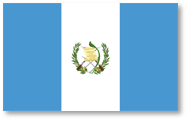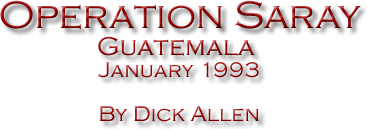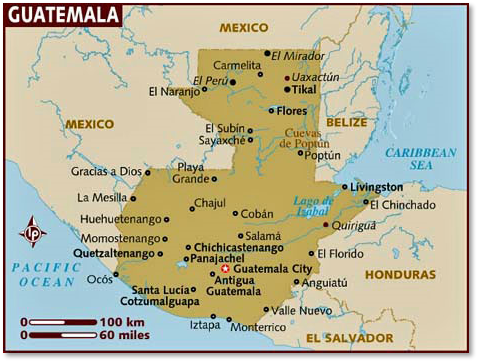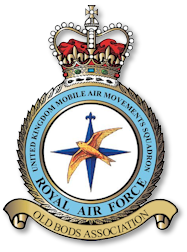

During the past decade the then elected government of Guatemala had pursued a policy of systematic persecution of the Indian population living in the North of the country in order to eliminate a certain terrorist element amongst their number. This had led to a mass exodus of these people to Mexico where for the last few years they had lived in relative peace and harmony in camps provided for them by the UN High Commissioner for Refugees (UNHCR). International pressure to reform humanitarian rights gave rise to an opportunity to repatriate these displaced people.
Unfortunately, due to a complex series of conflicts of interest and general disagreements, the UN refused the assistance of the Guatemalan military. The people moved and after a rather tortuous circular route through the country via the Capital, they returned to their homeland but now lacked food and shelter. The UN was then faced with the problem of moving some 500 tonnes of food aid to the north of the country from the capital, Guatemala City, with no assistance from the military. Hence a request from the International Community. Britain was the first country to respond by sending forces directly to the area.
Unfortunately, due to a complex series of conflicts of interest and general disagreements, the UN refused the assistance of the Guatemalan military. The people moved and after a rather tortuous circular route through the country via the Capital, they returned to their homeland but now lacked food and shelter. The UN was then faced with the problem of moving some 500 tonnes of food aid to the north of the country from the capital, Guatemala City, with no assistance from the military. Hence a request from the International Community. Britain was the first country to respond by sending forces directly to the area.
The Operation

Tuesday had been a whirlwind of activity with frantic planning and last minute acquisition of all the field equipment and compo rations required for a short stay in field conditions on a remote airstrip in the Guatemalan jungle. Transport arrived at 0200Z on Wednesday 27th January 1993 and OPERATION SARAY had begun. Still barley awake we boarded our VC10 at Brize Norton and took off for sunnier climes. Being a confirmed Hercules traveller, the thought of an 11-hour flight to Washington and then to Belize did not exactly fill me with a sense of deep joy. However, we were soon uncoiling our limbs in Belize and climbing into taxis to take us to our accommodation
The next day was interesting to say the least. I was flown along with the aircraft captain, Sqn Ldr Dave Rae and the Army G2 Intelligence officer into Guatemala to recce the strip to be used. After a spiral, steep approach, the Puma helicopter touched down and we were shown around by the local commander, accompanied everywhere by 2 heavily armoured vehicles and a host of soldiers. I felt safe? The captain completed his ground survey with a highly technical piece of equipment and informed the commander that a few of the taller trees near the edge of the runway needed to be removed. Within a few minutes parties of machete wielding Guatemalan soldiers were at work. It was time to leave and return to Belize.
The next day was interesting to say the least. I was flown along with the aircraft captain, Sqn Ldr Dave Rae and the Army G2 Intelligence officer into Guatemala to recce the strip to be used. After a spiral, steep approach, the Puma helicopter touched down and we were shown around by the local commander, accompanied everywhere by 2 heavily armoured vehicles and a host of soldiers. I felt safe? The captain completed his ground survey with a highly technical piece of equipment and informed the commander that a few of the taller trees near the edge of the runway needed to be removed. Within a few minutes parties of machete wielding Guatemalan soldiers were at work. It was time to leave and return to Belize.
We started the seemingly endless round of briefings. After the third in as many hours, we boarded our beloved green Albert and flew to the grass strip at Playa Grande, where after several low passes and an almost land (or was it a very low pass) we reviewed the work of the Guatemalan friends had done. On arrival in Guatemala City, it would be necessary to contact the commander again to ask for the removal of the last few trees for the operation to commence on Friday morning as planned.
Unfortunately, the expected field conditions had changed nicely into a 5-star hotel, which coped well with all our requirements. After a few copious cokes in the bar, we returned to bed in preparation for some arduous day’s work.
Unfortunately, the expected field conditions had changed nicely into a 5-star hotel, which coped well with all our requirements. After a few copious cokes in the bar, we returned to bed in preparation for some arduous day’s work.
Friday morning and the first load eventually arrived, consisting mainly of 110lb bags of corn, rice, soya, sugar and rolls of plastic sheeting which we loaded in four stacks along the aircraft floor, up to a maximum payload of 22,000lbs after the first landing proved successful. After a weather delay we took off for Playa Grande. Soon after landing and while the aircraft was still taxying, three sides of each stack had been undone and the nets laid to one side ready for the first offload.
The Guatemalan army arrived and together we unloaded the aircraft into waiting trucks, with the engines running, in about 10 - 15 minutes. This continued throughout Saturday and Sunday at the rate of 3 flights per day. Saturday night, we were invited to the British Ambassadors residence for drinks and a buffet. Not wishing to leave him with feeling that the evening had been unsuccessful we made suitable inroads into both and promptly after 2 hours we left for one of the local night-spots which turned out to be a most enjoyable evening.
The Guatemalan army arrived and together we unloaded the aircraft into waiting trucks, with the engines running, in about 10 - 15 minutes. This continued throughout Saturday and Sunday at the rate of 3 flights per day. Saturday night, we were invited to the British Ambassadors residence for drinks and a buffet. Not wishing to leave him with feeling that the evening had been unsuccessful we made suitable inroads into both and promptly after 2 hours we left for one of the local night-spots which turned out to be a most enjoyable evening.
On Sunday afternoon, we reloaded the VHF communication equipment that had been deployed with us and flew back to Belize. A day off to recover from a hectic 4 days and we were soon on our way home via Washington and Gander. Weather in the UK prevented us from continuing from Gander and so a night-stop was in order. Coming from tropical temperatures to minus 36 degrees was decidedly chilly. We returned to Lyneham the next day feeling that we had achieved the aim of the deployment, to bring some relief to a population rapidly running out of food and with no accommodation. UK International Rescue strikes again!



